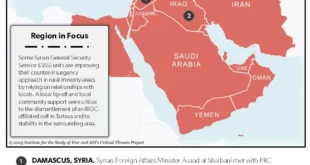The US is pivoting away from focusing on groups like al-Qaeda and ISIS — at least until the next attack.
On March 10, the US military carried out an airstrike near the town of Ugunji, a little more than 40 miles southwest of the Somali capital of Mogadishu. According to the US Africa Command, the strike killed three members of al-Shabaab, the al-Qaeda-linked militant group that controls a significant amount of territory in rural Somalia. Almost no information about the three targets has been released, other than local media accounts suggesting they were “organizing themselves … to carry out an attack.”
For much of the last two decades, this would not have been a noteworthy event. The US carried out hundreds of airstrikes and special operations per year across the globe, targeting transnational terrorist groups like al-Qaeda and ISIS.
Nowadays, though, strikes like the one in Ugunji are far more rare. That’s because the global US-led fight against non-state terrorist groups — the “war on terror” that dominated American foreign policy for the better part of two decades — is remarkably quiet these days.
The US is still involved in an ongoing conflict with Iran-backed proxy groups from Yemen to Iraq, and is controversially providing assistance to Israel in its war against Hamas in Gaza and lower-intensity conflict with Hezbollah. But the incident in Ugunji was the first US airstrike in Somalia in nearly a month, and there hasn’t been another one since then, according to data from New America, which tracks US counterterrorism operations.
Elsewhere, it’s much the same. During the Obama administration, Pakistan was the center of America’s drone wars, with at least 353 strikes carried out during his time in office. (Not to mention the Seal team raid that resulted in the death of Osama bin Laden in 2011.) But the last strike on Pakistani soil was in 2018. The US is believed to have carried out several strikes targeting al-Qaeda in the Arabian Peninsula — the terror network’s Yemeni branch — in early 2023, but none since then. (While strikes by the US military are generally publicly acknowledged, those carried out by the CIA are not, making attribution sometimes difficult.)
When US troops were withdrawing from Afghanistan in August 2021, President Joe Biden assured Americans that the fight against terrorist groups in the country — the ostensible reason the US had invaded Afghanistan nearly 20 years before — would continue. “We’ve developed counterterrorism over-the-horizon capability that will allow us to keep our eyes firmly fixed on any direct threats to the United States in the region and to act quickly and decisively if needed,” the president said in a televised address.
But in the nearly three years since, there’s been only one example of the US acting against a threat from Afghanistan: the August 2022 drone strike that killed al-Qaeda leader Ayman al-Zawahiri.
US counterterrorism operations also took another step back last month with the announcement that the US would be withdrawing its troops from Niger at the request of the country’s government, which came to power in a military coup last summer. In recent years, the US has had more than 1,000 troops based in the country, operating an extensive drone base to monitor militant groups in the North African Sahel region, an emerging hub of global jihadist activity. Troops have also been withdrawn from neighboring Chad at that government’s request.
Two countries where the war on terror is still ongoing are Iraq and Syria, where detachments of around 2,400 and 800 US troops, respectively, continue to take part in operations targeting ISIS alongside local partners. But even there, ISIS is a shell of the organization that once ruled over a Great Britain-sized “caliphate,” while the US and Iraqi governments have begun talks about winding down the long-term US presence in Iraq. Should Donald Trump win the presidency in November, we would likely see the withdrawal of the remaining US troops in Syria, an unrealized goal from his first term.
It’s clear that even if the “war on terror” isn’t quite over, it’s not the central organizing principle for US national security that it was for previous administrations. The Biden White House, unlike all of its post-9/11 predecessors, has yet to release a national counterterrorism strategy. In the National Security Strategy released in 2022, which heavily emphasizes “strategic competition” with autocratic rivals like China and Russia, terrorism receives just a one-page section, coming in after climate change and food insecurity. The White House has also issued new policy guidance to the CIA and Pentagon, placing more stringent limits and protocols that had been loosened by the Trump administration on drone strikes and special forces raids conducted outside of declared war zones.
As part of a larger restructuring, the US Army also announced it is cutting thousands of posts in roles most heavily involved in counterterrorism. “The mission or the function of counterterrorism has continued, but it just doesn’t have the same limelight and focus that it did,” Javed Ali, a counterterrorism specialist formerly at the FBI, Pentagon, and National Security Council, told Vox.
For the most part, this is an expected, even welcome shift in priorities. The kind of “forever war” counterterrorism approach of the post-9/11 years was often counterproductive then and would be hard to justify today.
But even as the US has rightly changed its priorities, the terror threat hasn’t fully receded — and may indeed be growing. Recent attacks in Iran and Russia by a dangerous new ISIS affiliate have some experts concerned that we’ve become too complacent to the threat. French authorities already say they’ve foiled a plot to attack this summer’s Olympics. Few want to return to the war on terror footing of years past, but that could happen quickly in the event of a catastrophic security lapse.
“A course correction was inevitable after 20 years of the global war on terrorism, and it was the right thing,” said Colin Clarke, a senior research fellow on counterterrorism at the Soufan Center. “There’s no justification for keeping resources at the levels we did at the peak of the fight against al-Qaeda or the peak years of [ISIS’s] caliphate.”
But, Clarke noted, “It seems like the pendulum has swung from one direction to the other,” leaving the US and its allies potentially vulnerable to a new attack. We may no longer be interested in terrorism, but terrorists are still interested in us.
Eyes in the sky – and on the ground
Today, the focus appears to be less on killing potential terrorists than on watching them. That’s particularly true in places like Afghanistan, which once was home to as many as 100,000 US troops, but where the US military now has no boots on the ground.
“My interpretation is that the main goal of the strategy for now is to monitor these terror groups in Afghanistan,” said Asfandyar Mir, senior expert in the South Asia program at the US Institute of Peace, who notes that there are still periodic sightings of what appear to be US aircraft over the now Taliban-controlled country. “What we haven’t seen is a lot of lethal action.” One notable exception was the Zawahiri strike, but that should be seen as an outlier. It’s hard to imagine any administration, no matter how disengaged, not taking the opportunity to kill Osama bin Laden’s successor and one of the principal architects of the 9/11 attacks.
These days, the main threat from the region appears to be the Islamic State – Khorasan Province, also known as ISIS-K, the regional affiliate of the global terror network. It was ISIS-K that was responsible for recent high-casualty attacks in Russia and Iran as well as the bombing that killed 13 Americans and more than 100 Afghans during the last stages of the US withdrawal from Afghanistan.
There’s no doubt that ISIS-K is on Washington’s radar. The US was able to provide fairly detailed warnings to both Russia and Iran prior to those attacks, though neither was apparently heeded. At a recent reporters’ roundtable, Gen. C.Q. Brown, chairman of the Joint Chiefs of Staff, told Vox that ISIS-K is “a group that we’ve been paying attention to for a number of years” and argued that “our ability to warn others about potential attacks shows you that we’re paying attention and we need to continue to pay attention.”
Beyond surveillance, much of the war on terror today involves providing training and assistance to local military partners fighting terrorist groups. In Iraq, for instance, the US participates in anti-ISIS missions with local Iraqi and Kurdish security forces. In Syria, it works with the Syrian militias that control much of the northeast of the country.
US troops are also working in so-called “train and assist” missions in countries from the Philippines to Jordan to Lebanon, though increasingly the focus has been on Africa. These deployments are less controversial than drone strikes and subject to less oversight than direct combat missions. (Members of Congress are often not even aware of them.) But they’re not without risk. In 2017, four US and four Nigerian troops, on a joint patrol, were killed when they were ambushed by a local ISIS affiliate. US-trained African troops have taken part in military coups in several African countries and have been accused of committing human rights abuses in others.
Still, experts are concerned that the US is withdrawing troops from Africa’s Sahel region — voluntarily or not — at a time when extremist groups there, including affiliates of ISIS and al-Qaeda, are growing in influence, carrying out more attacks, and threatening new territory.
“We’re not going to stay in a place where we’re not wanted, but we do have some diversity of relationships in the region,” a senior State Department official told Vox. “We have partnerships that are developing there.”
So far, the groups in this region haven’t demonstrated much interest in striking outside Africa, but as Dan Byman, senior fellow at the Center for Strategic and International Studies, put it to Vox, “It’s pretty hard to predict when these local groups are going to become international.” Somalia’s al-Shabaab — which has carried out attacks in multiple countries, struck US troops, and recruited US citizens — is a prime example of such a group.
The Somalia exception
Somalia is one country where the war on terror is continuing, to some extent, much as it did in the pre-Biden days. Other than Iraq and Syria, Somalia is virtually the only place where the US military still regularly reports counterterrorism strikes.
This may be partly due to the perceived threat from al-Shabaab. In the past, the group controlled much of southern Somalia. Today, its territorial control has been diminished but it is still active in many parts of the country. It has also launched several brazen attacks outside of Somalia in recent years, including a deadly raid on a US military base in Kenya in 2020.
Another reason is the nature of the strikes. Some of the Somalia operations have been long-planned targeted strikes against high-value targets, such as the commando raid that killed a senior ISIS financier in early 2023. But more often, according to New America’s data, they’ve been quick-response “collective self-defense” strikes in response to al-Shabaab attacks on the Somali military. This means they may not be covered by the new Biden policy imposing stricter standards on counterterrorism strikes. These strikes have been criticized by some experts who suggest the US is essentially providing air support for local land conflicts that have little to do with US national security interests, all under the cloak of counterterrorism.
The Trump administration escalated the drone war in Somalia, conducting a one-year high of 66 strikes in 2019, before trying to abruptly end it by ordering the withdrawal of troops from the country in late 2020. Biden reversed that move, redeploying troops to the country, but has conducted far fewer strikes, just 20 last year and seven so far this year. With little public interest or debate, the US military engagement in Somalia seems likely to continue at a low simmer for the foreseeable future.
Great power problems
As Aaron Zelin, senior fellow at the Washington Institute for Near East Policy, put it, “The US may want to focus on Russia or China or pull back from the Middle East, but ISIS doesn’t care about that.”
In fact, the shift to “great power competition” can hinder counterterrorist efforts and give extremist groups that still pose a threat to the US room to grow. Counterterrorism operations in the Sahel have become another domain of this competition, as French and US military deployments have been pushed out by several governments in favor of Russia’s Wagner Group, which provides security services with fewer questions asked or strings attached, in exchange for economic concessions and natural resources. (Wagner’s activities have continued under the rebranded name Africa Corps since the death of its founder and boss Yevgeny Prigozhin.)
These US and French deployments may not have been particularly effective at combating local militants, but all indications are that the Russians are even less so, and they have been implicated in a number of human rights abuses.
There’s also a critical lack of trust when it comes to monitoring terrorist activity. Groups like ISIS don’t map neatly onto larger geopolitical divides and they are helped by the fact that their many enemies are often enemies of each other.
The Russian government appears to have ignored highly specific US information ahead of the ISIS attack in Moscow in March and then blamed it, with no serious evidence, on Ukraine. Iran similarly blamed Israel, without evidence, for the ISIS attack that killed more than 80 people in the Iranian city of Kerman in January.
It hasn’t always been like this. The US and Iran were effectively allies, even if they didn’t directly coordinate, during the fight against their shared enemy ISIS in Iraq in 2014. Post-9/11 counterterrorism cooperation was a rare bright spot in US-Russian relations.
“There’s not the same consensus today that there was in the post-9/11 era,” said Zelin. At that time, “there might have been adversarial relationships with these countries and other countries, but when it came to terrorism, there was sort of a common language.”
It’s not only that countries aren’t cooperating. The US troops fighting ISIS in Iraq and Syria have actually been targets for Iranian-backed proxy groups, including in the drone strike that killed three US service members in Jordan this January.
Illusion of safety?
Gen. Brown acknowledged that the US military today is less actively involved in fighting terrorist groups. “It’s less active than it was over the past several years,” he said. Noting “all the things we have going on in the world,” Brown said that when it comes to terrorist groups, “the key goal for us is not only to ensure we don’t have a catastrophic attack on the homeland or one of our allies and partners.”
On that front, things have been quiet. There hasn’t been a lethal jihadist-inspired terrorist attack on US soil since the killing of three service members at a Naval Base in Pensacola, Florida, in 2019. (The 9/11 attacks aside, far-right-wing extremists have killed more Americans than Islamist militants have.) The number of these attacks in Europe has declined as well, though not as sharply.
ISIS-K’s recent massacres in Moscow and Iran, though, suggest that it has the desire and the ability to strike internationally. Western European authorities have also broken up several alleged plots by the group in recent months. Given the country’s recent experience with catastrophic attacks, French authorities are understandably concerned about threats to this summer’s Olympics.
“If you can do Moscow, you can do Paris,” one French expert on terrorism recently told the Economist.
And then there’s the risk that the October 7 attack and the massive outpouring of anger at Israel and the United States over the war on Gaza could fuel more terrorist attacks or be used by militant groups for recruitment. The surprise of the October attack is also a good reminder of the dismal record of governments and intelligence services at assessing when militant groups they thought were under control or neutralized can once again become a threat.
Could serious terror strikes, even on the US homeland, come back — and with it the “war on terror”? Consider the example of the Obama administration, which pulled US troops out of Iraq and attempted to pivot away from the Middle East and counterterrorism only to pivot back when the threat from ISIS became too big to ignore. Also worth noting: The post-9/11 authorization for the use of military force against terrorism, the legal basis for US military operations in more than 20 countries over the years, remains in effect.
“We really struggle with being judicious and parsimonious when it comes to counterterrorism,” said Soufan Center’s Clarke. “Despite 20 years of experience, we’re still very reactive and not proactive.”
There’s good reason to be glad that the US has moved on from the “war on terror” years. From the hundreds of civilians killed in US drone strikes to the abuses of Abu Ghraib, from CIA “black sites” and Guantanamo to the billions of dollars spent and thousands of lives lost in the wars in Afghanistan and Iraq, it’s not a chapter anyone wants to return to. But it could only take one major attack for that pendulum to swing back in the other direction.
 Eurasia Press & News
Eurasia Press & News



